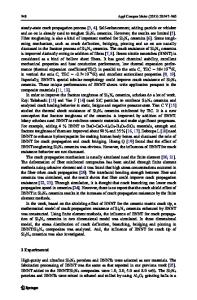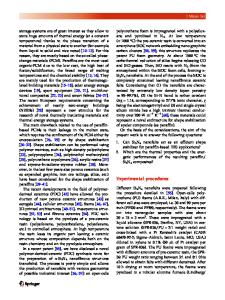Polymer-Derived Si 3 N 4 /BN Composites
- PDF / 384,743 Bytes
- 6 Pages / 420.48 x 639 pts Page_size
- 99 Downloads / 407 Views
POLYMER-DERIVED Si3N4/BN COMPOSITES Wayde R. Schmidt 1 , William J. Hurley, Jrl., Vijay Sukumar 1 , Robert H. Doremus t , and Leonard V. Interrante 2 , Departments of 1 Materials Engineering and 2 Chemistry, Rensselaer Polytechnic Institute, Troy, NY 12180-3590. ABSTRACT Partially crystalline silicon nitride, with a specific surface area greater than 200 m2 /g, is obtained by the pyrolysis of an organometallic, polymeric precursor under NH3 to 1000 OC. Additional heating to 1400 'C under N2 produces alpha-Si3N4. The addition of up to 15% h-BN was found to affect the coarsening characteristics of amorphous silicon nitride by promoting surface area reduction and suppressing crystallinity. By combining Si 3 N4 and BN molecular and polymeric precursors prior to ceramic conversion, or incorporating Si, N, and B into a single preceramic polymer, the relative proportion and crystallinity of the ceramic phases can be controlled in the resulting Si3N4/BN composites. INTRODUCTION Silicon nitride has a unique combination of properties which makes it an important material for high temperature and electronic applications. In addition to its resistance to thermal shock, creep, corrosion, and oxidation, dense Si 3 N4 has high electrical resistivity, a low coefficient of thermal expansion, low density, and good high temperature strength. These attributes are exemplified by the use of Si3N4 as crucibles, turbine blades, nozzles, tiles, bearings, cutting tools, and electronic components. Boron nitride is another useful material for high temperature and electronic applications due to its high melting point, low density, low coefficient of thermal expansion, and resistance to oxidation up to 1000 *C. BN is also transparent over a large spectral range and is often used as a boron diffusion source, a surface passivator, or a solid lubricant. A composite consisting of homogeneously dispersed BN in a Si3N4 matrix may exhibit beneficial properties of both components. To date however, limited research has been reported on such a material. Past work with Si 3 N4/BN composites has concentrated on their preparation by CVD and CVI techniques [I5]. Fukunaga, et. al. [1] prepared electrically conductive films of amorphous Si3N4/BN composites. They concluded that the 10 A voids within the amorphous Si3N4/BN composite were occupied by turbostratic BN since Si3N4 and BN do not constitute a solid solution even in the amorphous state. They also claimed a decreased free volume in the Si3N4/BN composite and an increased crystallization temperature of the amorphous Si3N4 matrix in the composite. Annealing at ca. 1600 *C led to precipitation of h-BN in the amorphous Si3N4. Hirai and coworkers [2,3] produced opaque and transparent amorphous Si3N4/BN composite films with up to 36% BN by weight using CVD. Mazdiyasni and Ruh [6] found improved electrical and thermal shock behavior of powder-based, hot-pressed Si 3 N4/BN composites over Si3N4 alone. The dispersion of the low modulus BN in the high strength, high modulus Si3N4 matrix significantly improved the
Data Loading...











